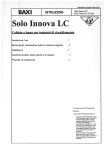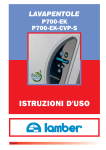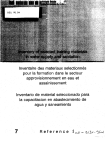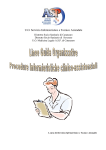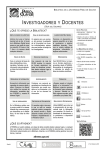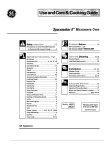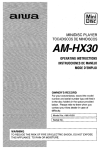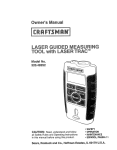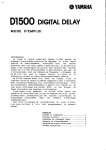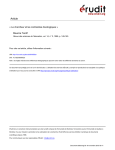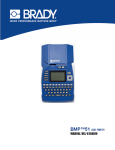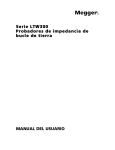Download MODURBAN Noviembre de 2006
Transcript
cP INFORME ANUAL DE PROYECTO1 APOYO COMPLEMENTARIO DE CONTRAPARTE PARA PROYECTOS DE COOPERACION INTERNACIONAL APROBADOS POR UNION EUROPEA Programa Bicentenarlo de Ciencia y Tecnologia Proyecto VI Programa Marco: MODURBAN MODULAR URBAN GUIDED RAIL SYSTEMS FP6-PLT-51 6380 Noviembre de 2006 El presente informe contiene informaciones y datos relativos at Proyecto MODURBAN, del VI Programa Marco de la Union Europea, y está por to tanto sujeto a condiciones estrictas de reserva y confidencialidad. CONTENIDO INTRODUCCIÔN ANALISIS DEL EFECTO DE INSTALAR UN SISTEMA DE INTERCIRCULACON ENTRE COCHES in. MANUAL TECNICO DEL SISTEMA MODENERGY IV. MANUAL DE USUARIO DEL SISTEMA MODENERGY I. ii. I. INTRODUCCION Investigadores chilenos participantes: Jorge Amaya, U. de Chile Rafael Correa, U. de Chile (responsable) Roberto Roman, U. de Chile Entidacles europeas participantes en el subproyecto: Aistom (Francia) Siemens (Alemania) Ratp (Francia) Bombardier (Alemania) Merak (España) Ansaldo Breda (Italia). La lista completa de participantes, asI como otras informaciones del proyecto, pueden ser vistas en: http:IIwww.modurban.orQ/ Formación de investigadores: Han participado activamente, además de los investigadores senior, dos investigadores jóvenes: Gufllermo Pobiete (Ingeniero Civil en ComputaciOn, Universidad de Chile) José Antonio Sanchez (tesista de IngenierIa Civil Mecánica, Universidad de Chile) Estos dos nvestigadores nan adquirido un expertise de alto nivel en el tema de modelamiento de ventilación en tnees y carros de Metro y transporte por trenes en general. Ambos contlnan en el proyecto por el año 2007 y se prevé que viajen a Europa durante el año para realizar pasantIas en algunas de las empresas europeas nvolucradas. El producto y su propiedad intelectual: El pri ncipal producto de esta etapa es un software de Balance Termal para simutación y análisis de ambiente al interior de tneies y carros de Metro. Los resultados de este producto, aplicados a casos especIficos fueron presentados en la reunion realizada en la Uiiversidad de Chile los dIas 2-3 de noviembre 2006, a la cual concurrieron expertos de las contrapartes europeas (Alstom, Siemens, Merak y Ratp). Se aplicó a los casos reaies de los sistemas de Metro de Paris, Madrid y Barcelona. Se prevé una aplicación sobre el caso de Santiago, pero esto depende de un acuerdo con la empresa, en relación ai uso de os datos. El software está en etapa final (Se afinan mejoras producto de la 61tima reuniOn en Chile) y es materia de protección intelectual, aunque debe considerarse en copropiedad con los socios del proyecto europeo. Este producto ha sido generado completamente en Chile, tanto en los aspectos dei modelo fisicomatemático como la programación computacional, nciuyendo las interfaces de usuarlo. La pnmera version se entrego oficialmente, tanto a los miembros del Consorcio coma a la ComisiOn Europea, en junio de 2006. Paralelamente, el 0MM mantiene la página Web wwwcmm.uchile.cVmodenergy, de acceso restringido a los miembros del Consorcio, en la cual reside la version actualizada a octubre 2006, completamente operativa y en uso actuatmente par los miembros del Consorcio involucrados en el producto. A través de esta página y de un Blog creado para ese efecto, los miembros del equipo en Chile interactUan con los participantes europeos. Movilidad: Durante el año 2006, se han realizado en Europa las siguientes reuniones de avance del proyecto, a las cuales han concurrido dos investigadores chilenos cada vez: Paris (Ratp): 23-24 de febrero Madrid (Merak): 22-23 de junio La tercera reuniOn se realizO en Santiago, los dias 2-3 de noviembre, con costos a cargo del proyecto chileno. La prOxima reuniOn está prevista para los dIas 6-7 de febrero, 2007, en los locales de Ansaldo Breda (Italia). A ella concumrán at menos tres miembros del equipo del CMM. Difusión at medio nacional: Como parte de la insercion de los resultados del proyecto en nuestro pals, e equipo de trabajo tomO contacto con la empresa Metro de Santiago, que derivO en un estudio que actualmente se esté realizando en el CMM, Sabre la temática: "Anâlisis del efecto de instalar un sistema de intercirculaciOn entre caches". Esta investigaciOn se onenta a simular y describir el comportamiento de los flujos de aire at interior de los carros, como una forma de proponer modificaciones que permitan una mejor ventilaciOn. Esta es una linea de trabajo que se está abnendo a nivel nacional, y que permitirä realizar en el futuro la transferencia de algunos resultados del proyecto Modurban at medio nacional. En la reuniOn realizada en el 0MM en noviembre 2006, se acordO iniciar gestiones tendientes a invitar at Metro de Santiago al Consorcio del proyecto Modurban. Este es un proceso que puede tomar alg&in tiempo, pero se espera al menos realizar Ia aplicaciOn de nuestro software a datos de Santiago, durante en el año 2007. El apoyo del Programa Bicentenano de Ciencia y Tecnologia El soporte del PBCT at desarrollo del proyecto MODURBAN en Chile ha perrnitido, por una parte, facilitar la movilidad de los investigadores (cuestiOn esencial en este tipo de proyectos internacionales) y, pci otra, posibititar la formaciOn de recurso humanos, a través de la participaciôn de jOvenes investigadores. Otro aspecto importante es Pa relaciOn que se ha establecido entre esta unidad académica ejecutora y una importante empresa nacional (Metro de Santiago), a través de un proyecto especifico de colaboración, actualmente en desarrollo. II. ANALIS1S DEL EFECTO DE INSTALAR UN SISTEMA DE INTERCIRCULACION ENTRE COCHES DEL TREN NS-74 (en desarrollo con Metro de Santiago) El estudlo Se busca mejorar las condiciones be ventilación en los trenes NS-74. Esto es, detern,inar los beneficios que implicarla en térrninos de contort, la mejora en la ventilación de los coches. En general el objetivo es mejorar la calidad be servicio y adaptar los trenes NS-74 a estándar be los trenes NS93 que poseen intercircuiación entre coches (tren Boa). Con la simulación se espera determinar: • El ectos en lateniperatura • Efectos en la sensación térniica al interior de los coches a distintos niveles be carga. • Efectos en la renovación del aire en los coches. • Contrastar con las, condiciones del tren NS-93 y establecer las desviacio nes. 2 Actividades del estudio Para concretar el objetivo del estudio se req ulere realizar rnediciones reales en los trenes de ternperatura, del flujo del aire al interior del coche y de cualquier otra variable necesaria para. efectuar la simulación, en los trenes NS-74 y NS-93. Para evitar la turbulencia entre los coches se debe considerar estanqueidad entre un coche y el otro (suponer un fuelle estanco entre éstos) Las actividades son: • Realizar rnediciones reales en los trenes (teniperatura, flujo del aire, etc.) en los trenes NS-74 y NS-93 • Simuar el efecto de reeniplazar las puertas actuales de los trenes NS74 por puertas 'perrneables' (con celosIas o rejilla que perrnitan el paso del aire entre los coches) • Sirnular la sltuación actual be los trenes NS-93 para contrastar con el tren NS-74 Smuar la situación considerando la instalación de un sistema mejorado de ventHación entregado por Metro en el tren NS-74, distinto a la moditicación de los pasillos 3 Resultados y productos ofrecidos. • Descripción y antecedentes del probema investigado, hip6tesis y supuestos de mode ación • S mulaciones y resultados computaconales • Conclusiones y recomendaciones. III. MANUAL TECNICO DEL SISTEMA MODENERGY: Simulador de Balance Termal en TUneles de Metro Project: MODURBAN FP6 Project: IP 516380 EC Contract n°: TIP4-CT-2005-516380 Subproject: MODENERGY WORKPACKAGE WP16: Prescription for HVAC's in a total system approach and development of an advanced optimization software to reduce energy consumption Document title: THERMAL BALANCE MODEL Prepared by: Jorge AMAYA Guillermo POBLETE Roberto ROMAN José Antonio SANCHEZ Date: October 26, 2006 "IW Centro de Modelamiento Maternático Universidad de Chile Abstract This document contains the basic assumptions and equations to describe the thermal balance model in a metro system. This model is based on a system of equations, arising from classic mechanics arid designed to be a part of a more detailed energy efficiency model. The goal of this model is to provide a rigorous justification for the construction of a software tool for simulation and optimization of a general metro line system. The software can be used to study the behavior of energy and heat exchanges in the tunnel, in order to propose efficient solutions for passengers comfort. Contents I Introduction 3 2 The Model 4 3 Thernal Balance 5 4 Heat Flow to Air () 7 5 Heat Flow to Ground (0; 8 6 Train Heat 11 61 First train heat, term 6.2 Second train heat.. term 6.3 Third train heat term 6.4 Fourth train heat term 6.5 P:wer calculatiuns .......................... 11 ......................... "F, . ......................... 12 ......................... 14 13 ................................15 7 References 19 0 I Introduction A train that runs on tracks out in the open does not significantly changes the thermal balance of the environment. The losses that it dissipates do not affect the outside conditions in a measurable way. But external conditions can and do affect the interior environment in a train. In effect, heat gained by radiation through glazing or by indirectly heating up the train skin can significantly impact the interior conditions. In a tunnel system the situation is quite different. The energy exchanges between the train and surroundings can significantly change ambient conditions. The model described in this document permits the analysis of this phenomenon in the following ways: • Energy balances: to categorize ener g y exchanges and properly identify the impact on energy consumption as well as thermal balance. • Prediction of ambient conditions, identify the conditions that will lead to uncom- fortable situations in a metro line. Evaluation of the impact of changes in the system: how a change in operation, tech- nology or other variables can affect energy expenditure in the system. 3 2 The Model The whole system can be conceived as a series of nodes interconnected by tracks. Each node is a station and the tracks link these stations. We assume that energy flows as electrical energy into electrical substations that are located at given places. From these substations a large amount of energy is injected into the train system, including ventilation and auxiliaries. From an electrical point of view, there are essentially two systems: the first one is the train, auxiliaries and traction power; the second one is a standard three phase system for stations, control and ventilation. The first one is a direct current system and the second one is alternating current. These systems can be considered as isolated. From a thermal and mass transfer point of view the systems are interconnected. Normally air enters stations, flows along corridors, platforms and tunnels, to be evacuated at ventilation stations inside the tunnel. Air gains heat and moisture from waste heat in the system and moisture released by passengers and other water sources. Heat is extracted from the system by: . Sensible and latent heat carried away by exhaust air. . Sensible heat transferred to the earth surrounding the tunnels. Nevertheless, from a thermal point of view, each track section is isolated from the rest of the line, and this generic situation is extended to the general system. So when we analyze a whole line, it will simply he the sum of track sections between stations. Thus a line will be a series of nodes that represent stations linked by tracks between them. Each track shall have the actual length between stations as well as the specific slope and curvature. Stations also have a specific length and temperature representing boundaries conditions for the calculation tool. 4 Therefore the whole system will be a sequence of nodes (stations) interconnected by arcs. 3 Thermal Balance For the analysis, we first see what happens with a single train from one given station to the next one. A train along a section of track has a distinct speed versus distance trajectory, that is defined by the system operator. Inside the tunnel we have to consider the following elements: • Train: is a thermal energy source. This energy comes from: rolling and air friction, braking losses, auxiliary power dissipated into the tunnel and passenger thermal load • Air in tunnel: it heats up in response to the thermal energy dissipated by successive trains. It is also a sink as it is evacuated from the tunnel. • Earth around tunnel: it is a thermal sink, since it can absorb energy from the air. The heat flow generated by the train (QT), in 'V, can be decomposed in the form: QT=QA+QG (1) where: QA heat flow absorbed by air, in W QG heat flow absorbed by ground, in W The final goal is to calculate the air temperature inside the tunnel. To achieve that, the heat overall exchange must be calculated. The tunnel is divided in discrete segments of length Ax, where the speed and the air tem perature are assumed constant, generating control volumes where the thermal balance could be calculated, as shown below in equation (2). The terms in Figure 1 are: 5 - Si OT °A Ax Xj1 Xi Figure 1; Thermal balance model length of segment in rn A = actual position of train in the x-axis A_i = previous position of train in the x ads = next station actual station and we consider the following assumptions: . A train is a car array • Each car has its own properties • We assumed mean values for what happen up and downstream the train midpoint. • The train midpoint concured whit the stations midpoint. • Trains are accelerating or braking by the time they enter or exit the tunnel. • Heat generated by the trains, as well as the third rail, is dissipated to the air in the tunnel. • Air transfer heat by convection to the tunnel walls and floor. • Heat is transferred to the g round by conduction. 6 • Radiative exchanges (short wave), between train and tunnel, are assumed to be negligible. The total thermal load along a section of track will depend on how many trains pass during a given time interval, the type of the train, its speed and the amount of transported passengers. In order to stabilize the flows inside the tunnel, we consider a one hour regimen, with constant frequency. The total heat generated by the trains (in both directions) is: (2) G +QA 0(QTi +QT0) 360 where: = heat generated by one train running on one direction QT, = heat generated by one train running on the other direction f trains per hour 4 Heat Flow to Air (Q) Air heat flow is calculated with equation (3), using stations temperatures [J, as shown in figure 2. Si si+1 Figure 2: Air jow inside the tunnel Air flow inside the tunnel is considered as an input and must obtained taking in to account that, air flows along the axis of the tunnel by three effects: first, by the air extractor system; second, by the piston effect of the trains; third, by chimney effect due to different air densities between the tunnel and external ambient air, as well as different elevations of stations. tbAP4CPA(T - T) (3) where: air flow inside the tunnel taking in to account air renovation, in m3 /s 1)4 PA = air density 1.177 k9/m3 C 4 = air specific heat = 1007 J/(kgK) T air temperature at x, in °C = air temperature at x_ 1 , in C Air properties change according to the pressure and temperature inside the tunnel but, at the temperature range that we are working, this properties do not varied significantly. We display below the typical values used (for atmospheric pressure and 300'K): . air kinematic viscosity (J1) = 1.857 kg/'(ms) . air thermal conductivity (NAT) = 0.02623 W/(mK) 5 Heat Flow to Ground (Qc) Earth temperature at the wall of the tunnel depends firstly on the heat transfer from earth surface to deeper layers. Secondly the air in the tunnel itself influences the earth temperatune at the tunnel wall H. The calculations are based on approximations for the earth temperature which varies with the season of the year and depth under surface. Heat transfer coefficients for the heat flow between air, tunnel wall and earth are estimated from material coefficients, flow properties and geometric parameters. The following restrictions are made for the current version of the program: • homogeneous earth is situated above and around the tunnel 8 • ground properties are constant For to calculate the heat exchange in the tunnel the total length of the tunnel is divided into segments which are treated step by step. Each segment is supposed to carry air of constant temperature so that heat exchange in the segment leads to a jump in temperature at the border between two segments. The heat exchange for each segment is: ixU (i - TEW) (4) where length of the segment, in m U L heat transfer factor per length of wall between bulk air and wall, in W/(mK) = air temperature at ;, in 0C TEw = earth temperature at the wall of the tunnel, in °C It is necessary to introduce a correction factor [] to represent the influence of the tunnel on the earth temperature. Then, comparing the heat flow from the earth surface to the tunnel, with the heat flow through the tunnel wall [], the corrected earth temperature at the wall of the pipe is: U*TEO+T, = where U* is the conductance ratio of heat transfer from earth surface to tunnel and from airflow to tunnel wail. This parameter U* is defined to take into account thermal conductivity of the earth, heat transfer coefficient between the airflow and the earth at the tunnel wall as well as the geometric configuration: 27r\ 1 in with: = ground thermal conductivity 1.5 W/(rnK) S 0 = depth of tunnel center under surface, in rn R0 = hydraulic radius of tunnel, in m The heat transfer coefficient per length of wall of tunnel Ur, depends only on h,., the heat transfer coefficient at the inner surface of the tunnel, in the form: UL = 2irR0 h (7) The heat transfer coefficient at the inner surface of the tunnel h% (which is measured in W/(m 2 K)) depends on flow properties, dimensions of the tunnel and material properties of the air in the tunnel [], in the form: 8 2R0 The Nusselt number Nu of air in a pipe depends on Reynolds number Re and thus on flow rate. For turbulent airflow Cnielinski [T] proposes the following approximation: Nu = O.O214(RE 8 - 100) P,0- 4 with: P Prandtl number of air R,. Reynold number The Reynolds number is basically the ratio of the inertial force of the medium over it viscous force. R - 2pVaRü C where 1/i, is air speed. The Prandtl number of air is taken as a constant (typically P 10 PD 0.72). The earth temperature at the wall of the tunnel not influenced by the tunnel (denoted TEo) is calculated from the ambient air temperature with its mean value Tm and its maximum value Tr, assuming a sinusoidal temperature variation throughout the year. TE0 = Tm - (Tmax - Tm)ecos(A - (9) A parameter describes the "thermal depth" of the tunnel. Heat flows from air to earth surface without resistance. = SO /- V o1 where: A = season constant (A=0 for summer and A=0.5 for winter) pc = volumetric heat capacity of ground, in J/mK to = duration of year, in s (1 year = 31,5 x 10 6 s) 6 Train Heat (QT) The heat generated by a train can be split in four terms, according on accelerating rate, the use of brakes, friction loses and constant heat values related with the passenger load, use of auxiliaries and others. Equation 10 shows the different train heat sources. QT Traction + Brakes + O (10) 6.1 First train heat term (T,.) Electric and mechanical inefficiencies are taking in to account as the train increases its acceleration. Traction are energy loses related with the differences between the motors electrical power consumption and power necessary for motion. The train was modeled as a dynamic system that moves along rails. The train has a certain mass (tare weight, load and rolling inertial mass). Forces that act on the train are: 11 inertia, roiling friction, air drag, forces due to curvature and forces due to slope. From the equations one can calculate the required force for the train to accelerate and thus the input power as well as the energy losses. = ( - P,,) ower) Trtzctian t \\77 with: mechanical power for motion in W electrical motor efficiency 77 The way the Power is calculated is further explained. 6.2 Second train heat term (B,.ake) As the train brakes one part of the energy needed to decrease its speed is re injected to the lines and the other is dissipated as heat. In this situation we have two cases. The first on consider only the work of regenerative brakes and the braking efficiency related to it. B,. ake = iE k (x,) Brakes = + LE(x) - RE Ek(x. ) + AE(x)I (1 - RECOV) with: recovered energy, in J RECOV recovery rate, 0 < e < 1 Ek(x) kinetic energy at z, in I E(x) = potential energy difference at x., in J 12 These energy terms are calculated as: Ek(x) = MTV2(X) dh(i) E(x) g>Mw dl(i) MT where: dh(i) = track bight difference with equal slope for a particular wagon in rm dl(i) track length with equal slope and curve radius for a particular wagon in m mass of wagon i, in kg The second case, suppose that for a particular speed regenerative brakes are almost useless and mechanical breaks are used. Thus this specific speed is considered as input. - Ek (x._ l )] + E(x) Brke where: kinetic energy at x.. 1 , in J 6.3 'Third train heat term This term considers friction from wheels to rails or train to air. The amount of energy dissipated on friction is calculated as the power wasted due to Aerodynamic Drag Forces and Curve Forces, plus the Rolling Friction Force work. (F + F) V(x)Lt FjAx where: = drag force, in N FR = rolling friction force, in N FC = curve force, in N V(x) = train speed at x., in rn/s The way this forces are calculated is further explained. 13 6.4 Fourth train heat term (OD.) The fourth term considers the heat generated by electrical auxiliaries (lights, ventilators, cooling systems and other electrical systems), passengers and thermal losses from the third rail or joule losses in motors and other electrical elements. Others = Pass + Aux + TR + MC with: Pass Aux TR iVic passengers thermal load, in W electrical auxiliaries, in TV third rail effect, in W = melting of conductors, in W Each passenger is a thermal load of about 110 Watts, therefore the total load will be: Pass = NQ where N represents the number of passengers and in W. a single passenger thermal load, Auxiliaries (lights, ventilation and HVAC systems), is assumed to be constant in each car. In order to perform the calculations we use the average Auxiliaries value. The third rail effect or joule effect, depends on the line electrical resistance, which varies with the distance from the nearest electrical substation. TR = R(xi)l' with: R(xi ) = line electrical resistance in Q I = current intensity in A 14 As a formalism we include the heat generated by the melting of the conductors, but we consider this term to be irrelevant for our calculations: V Pv[10, with: jVzos t = mass lost in conductors per hour, in kg/hour = conductors material latent heat, in J/kg CL 6.5 Power calculations In order to achieve a specific speed, the train has to overcome all the forces that are against its motion. Therefore the inlet power can be conceived as the result of multiplying this forces with the train speed and adding the power waste in to Rolling Fiction work Power(X i ) - F(x)V(x) FX F(x) = F, (x,) + FD (x,) ± F(x) + FS (x,) where: = power generated by the motors at ;, in W = forces over the train at x, in N F(x) The force needed to accelerate the train can be broken down into the following components: • Inertial Forces (F1 ). To move forward, the train must provide enough energy to overcome the train inertia, which is directly related to its weight. F1 = ( MT where: Mr train inertial mass, in kg a(x) = train acceleration, in rn/s2 15 - M1)'a(x) • Rolling Fiction Force (FR ). It is conceived, as force necessarily to move the wheels forward and is directly proportional to the weight of the load supported by the wheels. The magnitude of the friction force is [ ]: FR = MT9K1 where: FR rolling friction force in N K1 kinematic friction coefficient g = gravity acceleration in rn/s2 • Aerodynamic Drag (PD). The force exerted on a train moving inside a tunnel, depends in a complex way upon the velocity of the train relative to the air, the viscosity and density of air, the shape of the train, the roughness of its surface and the tunnel cross-sectional area FD = AFCDp4V2(x)aT with: FD = aerodynamic drag force N AF = train frontal area m2 CD = drag coefficient aT = tunnel parameter For small values of the Reynolds number (called laminar flow since the flow is nonturbulant) the drag coefficient is inversely proportional to the velocity. This means that the drag force is only proportional to the train velocity. When the flow is turbulent the Reynolds number is large, and the drag coefficient CD is approximately constant. This is the quadratic model of fluid resistance, in that the drag force is dependent on the square of the velocity. 16 • Fbrce due to Tack Curve (Fe). These force is a result of the change in the accelerating vector. V2Mwr() with: force due track curve in N V r = train speed at; in m/8 curve radius for a particular wagon in m .. LA LF tI Lc L LE LB Figure 3: Errnm pie sketch of train model In the example, the force due curve, is calculated as shown: ^M' 1 + MR + Mrs 1 + MD _1 + ME _1 + MR _ 1 T(o_Lc) • Force due to Track Slope (Fs). Not always this force plays against motion. It depends on the direction in which the train is moving, down or up stream. 17 with: F 3 force due track slope in N As shown in figure , in order to evaluate the slope force we used the approximation: L dl (Q _ LA dl(0_L3) + JWC + MD 1(o-Lc) 18 dl(0+L0) + IVI dl(QLE) 7 References [1] W. M. Rohsenow and J.P. Hartnett, Handbook of Heat Transfer, McGraw-Hill Boock Cornpaby, New York, 1973. [2] St. Benkert, F.D. Heidt, D. Schöler, "Calculation tool for earth heat exchangers GAEA," Department of Physics, Untversity of Siegen, D-57068 Siegen, Germany. [3] K.J. Albers, Untersuchun gen zur Auslegung von Erdwdrmeaustauschern fIr die Konditwnierung der Zuluft fith' Wohngebdude, Ph. D. Thesis, Universität Dortmund, Dortmund, 1991. [4] H.L. von Cube, Die Projektierung von erdverlegten Rohrschlan g en fr Heizwiirmepumpen (Erdre oh- Wcr'meauel Ia), Klima + K 1te-Ingenieur, 1977. [5] V. Gnielinski, Neue Cleichun gem fur den Wdrmeund den Stojjdberga7sg in urbulemt durchstromtem Rohren und Kandlen, Forschung im Ingenieur-Wesen, 41, 1975. [6] Dan B. Ma.rghitu, Mechanical Engineer's Handbook, ACADEMIC PRESS, 2001. [7] Edward H. Smith, Mechanical Engineer s Reference Rook, Buttenvorth-Heineman.n,Twelfth edition, 2000. [8] John H. Lien.hard IV and John H. Lienhard, Mechanical A Heat Transfer Tezt.Book, Phlogiston Pre.ss,Third edition, 2000. 19 List of notations Simbol Description QT heat flow generated by the train in W heat flow absorbed by air in W QC = heat flow absorbed by ground in W length of segment in rn actual position of train in the x axis = previous position of train in the x axis S 1 = next station = actual station QT, = heat generated by train running on one direction in J QT, f heat generated by train running on the other direction in J = frequency of trains per hour 3600 =l hour in s w A = air flow inside the tunnel taking in to account air renovation in m3/s air density in kg/m3 PA C A T, = specific heat of air J/(kgK) air temperature at x, °C air temperature at x 1 OC = length of the segment in rn UL = heat transfer coefficient per length of wall of tunnel between bulk air and wall in W/(rnK) 'Ti = air temperature at x j in °C TEW = earth temperature at the wall of the tunnel in °C = conductance ratio of heat transfer from earth surface to tunnel and from airflow to tunnel wall ground thermal conductivity in W/(mK) (typically: ..\ = 1.5 W/(mK) 20 Simbol Description S0 = depth of tunnel center under surface in rn R0 = hydraulic radius of tunnel in rn h% P. heat transfer coefficient at the inner surface of the tunnel in 'V/(m2K) = air Prandtl number Reynold number = air speed A = season constant (A=0 for summer and A=0.5 for winter) t 0 = volumetric heat capacity of ground in J/rn3K = duration of year in s (1 Y 31.5 106 s) Pass = passengers thermal load in W N = passenger number Qpass Aux TR single passenger thermal load in W = electrical audJiaries in W third rail effect in W AIC = melting of conductors in W R(x) = line electrical resistance in I = current intensity in A = mass lost in conductors per hour in kg/haw' CL = conductors material latent heat in I/kg = mechanical power for motion in W 77 = electrical engines efficiency Ek (x) = kinetic energy at x in I E, (x i ) = potential energy at x6 in I V(x) = train speed at x in m/s = actual position of train in the z axis = previous position of train in the z axis = I wagon mass in kg 21 Simbol REnrg j Description - = recovered energy in J RECOV = recovery rate 0 e 1 kinetic energy at x_1 potential energy at ; in J in J P7wer(Xi) = power generated by the motors at x in W F(x) = forces over the train at x in N mean train inertial mass in kg a() = train acceleration in rn/s2 FR = rolling friction force in N K1 = kinematic friction coefficient q = gravity acceleration in rn/32 FO = aerodynamic drag force N A? = train frontal area rn2 CD = drag coefficient cT = tunnel parameter force due track curve in N Fs = force due track slope in N dh = track bight difference with equal slope in rn dl 7' track length with equal slope and curve radius in rn = curve radius in rn 22 IV. MANUAL DE USUARIO DEL SISTEMA MODENERGY: Simulador de Balance Termal en TUneles de Metro Mc:FNTR() DE N-10DEIAMIENTO Modenergy V3.0 User Guide Last Updated: 2006-09-24 Copyright 2006 CMM This material may be distributed only subject to the terms and conditions set forth in the CM Software License, vi .0 or later (the latest version is presently available at http://www.cmm.uchile.cl/License.html Table of contents Chapter 1: Installation • Requirements • Normal installation Chapter 2: Concepts and basics • Introductions • New Features and Fixes • Architecture • Correspondence between Software and Thermal model • A First Look Chapter 1: Installation Requirements 1. Microsoft® Windows 2000 with Service Pack 4, Windows XP Professional or Home Edition with Service Pack 2, or Windows XP Tablet PC Edition, Windows 2003 Server. 2. . NET Framework Version 1. 1 Red istributable Package download from (http:INvww. microsoft. corn/downloads/details. aspx?FamilvI D=262d25e3f589-4842-8 1 57-034d1 e7cf3a3&displaylanq=en) 3. 2 GHz Pentium IV class processor or better 4. 128MB of RAM mm, 256 MB or greater recommended 5. Up to 2 MB of available hard-disk space Normal installation 1. For a successful installation of ModEnergy Software, administrative access to your PC may be required, which is normally provided by your IT department 2. Click the Download Now button. A dialog box will appear asking you where to save the Installer, 3. Save the Installer on your desktop, and wait for it to download completely. 4. An Installer icon will appear on your desktop. Double-click on it. 5. The installation program will be started automatically. McdEreroy Welcome to the ModEnergy Setup Wizard The insta ter *illqudevouthrough rho steps required -o install ModEnecgyonyour computer WARNIN3: This computer program to protected by ccpyngh law and interiotunni treaties. Unautionzod duplication ci distribution of the pcolyanr, or any portion Ott na y result in severe civil ur rirniritt poriestins, arid will tie uruseLutee Lu tin rriuoiirijrri sixterti pusoiti e uriiitrr Ilm ltw. I ioe(i!-L' 6. Read and accept the license agreement roocterg'i License Agreement : P ease toke a mment to rood t,e license agreenrerrt now. itou acethe terrors belew. dick Aroo. their 'uxt° Cthguv,rrro click CancE. SOflWAEI USER FT ALl U1ON IJfTNCT: PROUtCI: SIODENFISCY fl.inr,. o.oarllit.g ont erno.tt.tIiogthis Prodoir. pI.tt ttird ..r.htlh no.1 nrr.pt the tenot eonditiott of hot licence ,elow tkeo choose the! A-g ree honnu it the henna of the page. Do not install It!. Pr.dur. if sot do no. opt. to he bras ad rondluons of the heence. sINGLE tSFRUCFNCE ItEMS £'el) CpNDONS RIIEV.5.T t'FOWtJSISON • This licence relates to he restate sensoon of the ?nodric dehoed 1e100 Deroils (LOLLIiJIIOhCSOLUIL u! the PIUdLLCLcOII 01 the fulls he Coast! o,sCsThi ctnte. • There are rio characi for usooc tho testing version of the Product • orients relcesno to the ?nodnct should oe adOresseOto _sCs_ the tuovuler of (oroeI I rk the Ftodum (- at the Nt.?......... 7. Determine the place on your hard disk where you want Modenergy to be installed. Normally, the proposed "c:\program tiles\CMM\Modenergy\ "will do fine. Or else, just browse to the directory where their current Modenergy version is found and select that as destination directory. 4odEregv (t) Select Installation Folder fl r Iwi nt1I '1jdErry tj Cc Ioc.c rq lok1cr Tn nnt,I nthrfctr p rIw: Nrt Tr nor, tn r,dJfprp r5inI,1 p r tnr,tbctrw. or I,rk Rroo -older: ( '. \ rnujrn n r ni\UMhrFrro.,rJA lisoCcr1.. lnsr3l Mcdnercv tar vou,seif, or for arwons wflc uses iCc coinpiter E y- Cn I ( ( 8. Select 'Next and you're done! The installer will take care of all the work. n4odEcg1 - ( Confirm Installation The in smieris rod'10 install Modnerqy on yorcornpiter. aicc Nexrtc niOtiCe inO:ooCcn LalcnI I -nbacx 9. When installation status becomes ok, select close button and start to using the software e jJ Installation Complete - ModEneigy has been sucxessfdly ristalted I Click lose !o uxit Please use Windows Upcate to hEckfor any crhc.N updates to tie NET Framework 10.If you need to remove Modenergy go to control panel and choose add or remove programs, select Modenergy and remove. Add or Remove 'roprafli, Irnfl.r,iieiienl 20t V 5,-re - tt,irdii M crocft SQL Sere Deciduc Liene mrn, j J M rrcrctt SQL Sere , Deridoc Eiene fiherePount) iii accoSt ,si,l Sit 5393118 S ze 7 3J21tS S., :3: 5001,12 S 2)90 F.edusrrlbLteble POc1aoe M cr0500 Vis,al is Recuslrubutable Package 2.2 Beta AOd ne Prcraris Sd n,r0 115 Uccosoft Vi Igi Sd croi,,ft .n,e Add Men,,., VihdCi.s I Sri ,aiena i s 54P1 c .5 ctoo0 f ir.fl. ciii, PWT Fnee-ts, A,rr,ien-t ;()A5SAudit 20C Toa,n Sure hduton Etta2E.ug ler S5,udio Totlo for COtte SsMte,M ZOOS Soruturce Beta 2 t.sdio T000 for OreS, 3,cr, s SOMR 00MB 131.16 1 zt 00t run,i,r Eta = 2 1 I au LKPd on 30-17-, 005 Remove Mall F rox 1.3) 5 36MB 5 os usalia 5.05,-S 3.2 ( Mozulla Thinuerburu ii.Si Za MCN LArSen - Acru 2003 S is S 2' 6515.56 45 1,1MM e Chapter 2: Concepts and basics Introducing ModEnergy V3.0 ModEnergy is powerful and easy-to-use software for a thermal simulation of a Metro system, designed for the demanding needs of the project, the software is based in our model, the way it was conceived and how one can use it to deal with "what-if' scenarios. We have made some simplifications, but this actual model can be improved, instead of using empirical parameters for the model, we decided that the best approach was from a strictly physical point of view. Thus the system is modeled as dynamic systems (the trains) that move between stations and this system has certain energy inputs and outputs. Then we have the tunnel system that interacts with the energy exchanges that rise from the train system. • Train model: The train was modeled as a dynamic system that moves along rails. The train has a certain mass (tare weight, load and rolling inertial mass) and one wants it to follow a certain acceleration and deceleration curve. Forces that act on the train are: inertia, rolling friction, air drag. From the basic equations one can calculate the required force for the train to accelerate and thus the input power as well as the energy losses. • Speed I distance track: From basic kinematics, we use the speed versus distance for this simple model. We had to use a 1 meter interval to have good enough approximations. One can input and change parameters such as: mass (empty, passengers and inertia), the acceleration versus distance profile, rolling resistance, drag coefficient and the power dissipated by auxiliaries. Braking efficiency actually can be modified. • Kinematics results: Besides the speed versus distance profile, one also obtains the force necessary to accelerate the train and also the different losses, including braking losses. These are presented both as kW as well as kJ per meter. From these results it is evident that, except during braking, one important loss to the tunnel is due to auxiliaries. As the train moves along the track, there is power dissipating as heat. This is then calculated as energy dissipated per meter of track when a train passes. For the moment, we suppose the track is horizontal and straight. It should not be too difficult to incorporate slopes and curves. The basic idea of this approach was to have a good breakdown of the different forces that act upon the train and then compare these with real cases of study. New Features and Fixes Modenergy has been redesigned for improvement the new characteristics Here's what's new in ModEitergy V3.0: • LI I - We developed a new UI, improvements to product usabilit y including descriptive object, redesigned options menu, working area and data management. • Fixes bug - Fix crucial Core layout architecture bugs, paving the way for a more maintainable, performant, and extensible future. • New c haracteristics - like: • engine thermal analysis 3.0 • aiding train parameters • adding Lines with non homogeneous Stations • adding trains with non homogeneous car • adding curve and slope • Pdf Report ModEnergy V3.0 Architecture The new ModEnergy architecture using three tier model: M S u, s e s s m m 2ju N m 1 s t, j s^ i n e; S. U s i n C- 7 ss' Correspondence between Software and Thermal model Distance (m) = distance profile vector in x axis by one or all station Speed (mis) = Speed profile vector in x axis by one or all station Time interval (s) = tj-t=21 (Vi - V1i)*(x,xi) Aced (mis2) = acceleration = (Vi - V 1 )i( ti Kinetic Energy (J) = kinetic energy at xi, in J (ref Thermal Balance Model page 14) Potential Energy (J) = potential energy at xi, in J (ref: Thermal Balance Model page 14) Inertial Force (N) = Inertial Forces (ref Thermal Balance Model page 15) Aerodynamic Drag Force (N) = (ref Thermal Balance Model page 16) Curve Force (N) = Force due to Track Curve (ref: Thermal Balance Model page 16) Slope Force (N) = Force due to Track Slope (ref: Thermal Balance Model page 17) Mechanical Power (W) for motion (ref: Thermal Balance Model page 15) Train Heat (Qt) = (ref: Thermal Balance Model page 11-14) Earth Temperature = earth temperature at the wall of the tunnel, in °C (ref Thermal Balance Model page 10) Air Temperature = air temperature inside the tunnel in C. is the result of the thermal balance shown in the Thermal Balance Model page 6. A First Look at Modenergy When you first open Modenergy, you see the following areas: Menus The menu contains two shortcuts: . Exit menu - Close the application. • Help menu - Contains documentation and informational links. o About - Informational dialog about Modenergy, including the current software version number. Other information that is provided includes the copyright and team developer.











































